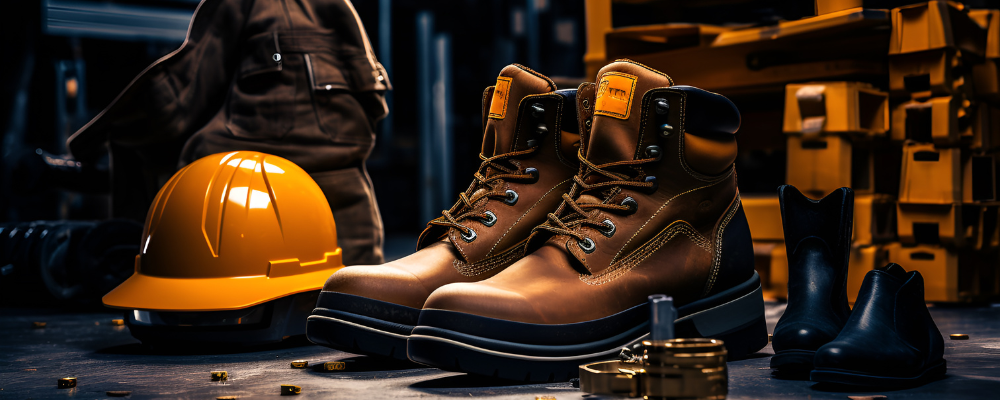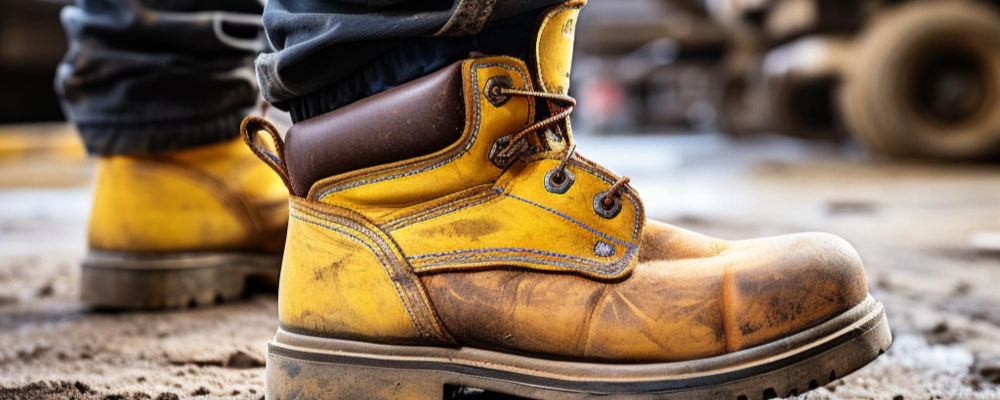
Introduction:
In the high-risk environment of construction, prioritizing safety is paramount. Your choice of work boots can significantly impact your safety and well-being. At Site and Safety Solutions, we understand the importance of selecting the proper work boots to protect construction workers. This comprehensive guide delves into the technical aspects of work boots, emphasizing the Protector Boot, Portwest Monsal Hiker Boots, and Men’s Thorogood 6″ Steel Toe Work Boot.
Understanding the Essential Features of Work Boots
Construction workers require work boots that offer more than just style. Our range of work boots is engineered to meet the highest safety standards:
A. Protective Toes:
- Steel Toe Caps:
- Steel toe work boots, such as the Men’s Thorogood 6″ Steel Toe Work Boot, offer unparalleled protection against heavy falling objects.
- Composite Toe Caps:
- The Protector Boot incorporates composite toe caps for those seeking a lightweight alternative without compromising safety.
B. Slip Resistance:
- Outsole Traction:
- Our Portwest Monsal Hiker Boots have robust, slip-resistant outsoles, ensuring stability on uneven surfaces.
C. Electrical Hazard Protection:
- EH-Rated Boots:
- Construction sites often pose electrical hazards. Opt for EH-rated boots to safeguard against electrical shocks and accidents.
D. Waterproofing:
- Waterproof Work Boots:
- Keep your feet dry in wet conditions with waterproof work boots, an essential feature for outdoor job sites.
Selecting the Right Size and Fit
Ensuring the correct size and fit is paramount when choosing work boots for the demanding construction work environment. Ill-fitting boots can not only cause discomfort but also compromise safety. Here, we provide a detailed note on selecting the correct size and fit for your work boots to ensure both comfort and safety.
A. Measuring Your Feet:
Accurate measurement of your feet is the foundational step in choosing the right-sized work boots. Follow these steps to measure your feet accurately:
- Use a Brannock Device: This is a specialized measuring tool commonly found in shoe stores. Place your foot on the device with your heel snugly against the back heel stop. Ensure your weight is evenly distributed on both feet.
- Measure Both Feet: It’s essential to measure both feet, as they may not be the same size. Always use the measurements of the larger foot when selecting work boots.
- Length and Width: Take note of both the length and width measurements. The size is crucial to ensure your toes have adequate room, and the width measurement helps you avoid too tight or loose boots.
- Consider Socks: If you typically wear thick work socks, measure your feet while wearing these socks to ensure the boots will accommodate them comfortably.
- Arch Type: Pay attention to your arch type, whether flat, neutral, or high. This information may affect your choice of insoles for additional support.
B. Consider Insoles:
Selecting the right insoles for your work shoes can significantly enhance comfort and support during long work hours. Here are some key considerations:
- Arch Support: Insoles come in various arch support options, including high arch, low arch, and neutral arch. Choose insoles that match your foot’s natural arch to alleviate discomfort and reduce the risk of arch-related issues.
- Material: Insoles are made from various materials, such as foam, gel, or custom orthotics. Gel insoles provide cushioning, foam insoles offer shock absorption, and custom orthotics are tailored to your unique foot shape and needs. Consider your specific requirements and the support your work boots lack.
- Impact Absorption: For jobs that involve heavy impact, like construction work, opt for insoles with superior shock-absorbing properties. These insoles can help reduce fatigue and protect your feet and joints.
- Moisture-Wicking: If you expect to work in conditions that cause your feet to sweat, moisture-wicking insoles can help keep your feet dry and comfortable.
- Replaceable Insoles: Check whether your boots allow for the replacement of insoles. Some boots have removable insoles, making switching to custom or specialized insoles easier for improved comfort.
In conclusion, proper measurement of your feet and selecting appropriate insoles are pivotal in ensuring your boots provide the comfort and support needed for construction work. Site and Safety Solutions is dedicated to helping construction workers make informed choices regarding work boots, and we recommend following these guidelines to guarantee the perfect fit and maximize both comfort and safety on the job.

Maintenance and Care
These boots are a substantial investment in the safety and well-being of construction workers. Ensuring the longevity and effectiveness of your work boots is essential, as they play a pivotal role in protecting your feet and providing the necessary support. Proper maintenance and care are vital to maximize the return on your investment and guarantee the continued performance of your work boots.
A. Cleaning and Inspection:
Regularly cleaning and inspecting your work boots is a fundamental aspect of maintenance. Here are some critical steps to follow:
Cleaning:
- After each workday, remove any loose dirt or debris from the boots. It can be done by tapping the soles together and using a brush to sweep away stubborn particles.
- Use a damp cloth or sponge to wipe down the exterior of the boots, ensuring that any mud, grime, or other contaminants are removed.
Thorough Cleaning:
- Remove the laces and thoroughly clean all parts of the boot for deeper cleaning.
- Soak the boots in warm, soapy water, and gently scrub with a soft brush.
- Rinse the boots and allow them to air dry, avoiding exposure to direct heat sources, which can damage the materials.
Inspection:
- Regularly inspect your work boots for wear and tear, including loose stitching, damaged leather, or cracks in the sole.
- Check the condition of the outsole, insole, and midsole for any issues that may affect comfort and safety.
Waterproofing:
- If your boots are not waterproof, consider applying a waterproofing treatment to protect them from moisture. It is essential for outdoor work in wet conditions.
B. Replacing Insoles:
Insoles are an integral part of your boots, contributing to both comfort and support. Over time, insoles can wear out, losing their cushioning and arch support. To maintain the ease and effectiveness of your work boots, promptly replace the insoles when needed.
Signs of Insole Wear:
-
- If you experience discomfort, reduced support, or increased fatigue while wearing your work boots, it may be a sign that the insoles are no longer providing adequate cushioning or support.
Replacement Insoles:
-
- Invest in high-quality replacement insoles that are specifically designed for work boots. These insoles are often engineered to provide superior comfort and support.
Proper Installation:
-
- Follow the manufacturer’s instructions for replacing insoles to ensure a proper fit and function.
C. Resoling:
Resoling is an effective way to extend the life of your work boots and is particularly valuable for those with high-quality, durable boots that have seen extensive use. A professional cobbler should perform resolving to guarantee the best results.
When to Consider Resoling:
-
- If the outsole of your work boots is excessively worn or damaged, resoling is a viable option. Signs of extensive wear include smooth or uneven tread patterns, holes, or visible cracks.
Cobbler Consultation:
-
- Consult a professional cobbler experienced in resolving work boots. They will assess the condition of your shoes and determine the appropriate resolving method.
Materials and Quality:
-
- Ensure that the cobbler uses high-quality materials that match the original outsole of your boots to maintain their safety and performance standards.
In conclusion, proper maintenance and care of your work boots are vital for ensuring their longevity and effectiveness. By regularly cleaning, inspecting, replacing insoles, and considering resoling when necessary, you can maximize the lifespan of your work boots, reduce the risk of workplace injuries, and continue to benefit from their support and protection. Your work boots are an investment in your safety and comfort, so giving them the attention they deserve is essential.
Extended Durability with Site and Safety Solutions
Site and Safety Solutions is your trusted partner regarding these boots for construction workers. Our products, including the Protector Boot, Portwest Monsal Hiker Boots, and Men’s Thorogood 6″ Steel Toe Work Boot, are rigorously tested to meet industry standards. We prioritize your safety without compromising on comfort and style.
For more products, visit our website.
Men’s Thorogood 6″ Steel Toe Work Boot (U.S.A.)
Portwest Monsal Hiker Boots S3 WP HRO
Conclusion:
Selecting the proper work boots is paramount for construction workers who face daily hazards on the job. At Site and Safety Solutions, we’re committed to offering a range of technically advanced work boots to ensure your safety and comfort. Prioritize your well-being by choosing the Protector Boot, Portwest Monsal Hiker Boots, or Men’s Thorogood 6″ Steel Toe Work Boot. Your safety is our priority.
For more information, visit our website and Facebook page.










